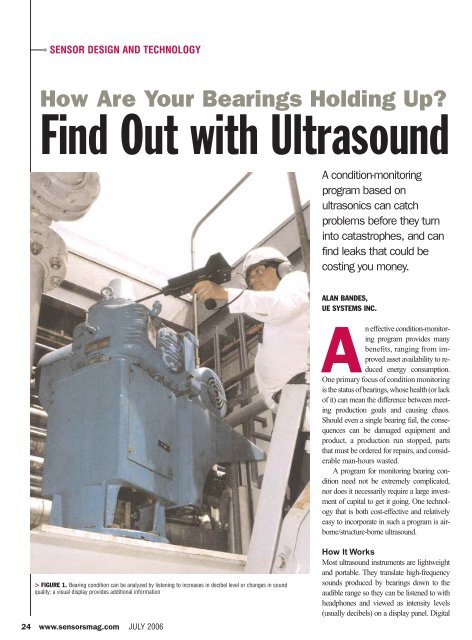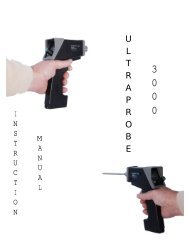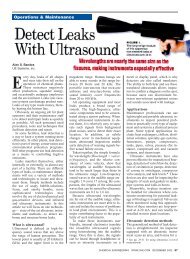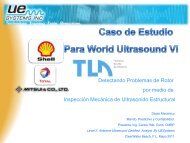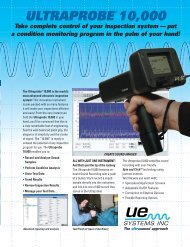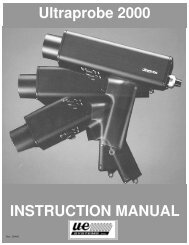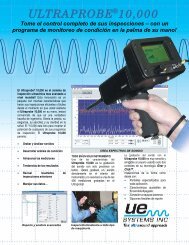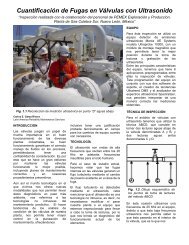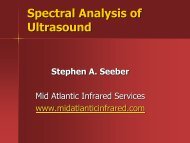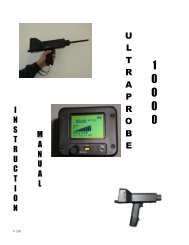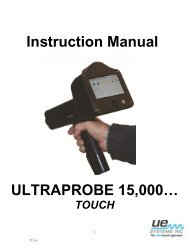How Are Your Bearings Holding Up? - UE Systems
How Are Your Bearings Holding Up? - UE Systems
How Are Your Bearings Holding Up? - UE Systems
Create successful ePaper yourself
Turn your PDF publications into a flip-book with our unique Google optimized e-Paper software.
° SENSOR DESIGN AND TECHNOLOGY<strong>How</strong> <strong>Are</strong> <strong>Your</strong> <strong>Bearings</strong> <strong>Holding</strong> <strong>Up</strong>?Find Out with UltrasoundA condition-monitoringprogram based onultrasonics can catchproblems before they turninto catastrophes, and canfind leaks that could becosting you money.ALAN BANDES,<strong>UE</strong> SYSTEMS INC.An effective condition-monitoringprogram provides manybenefits, ranging from improvedasset availability to reducedenergy consumption.One primary focus of condition monitoringis the status of bearings, whose health (or lackof it) can mean the difference between meetingproduction goals and causing chaos.Should even a single bearing fail, the consequencescan be damaged equipment andproduct, a production run stopped, partsthat must be ordered for repairs, and considerableman-hours wasted.A program for monitoring bearing conditionneed not be extremely complicated,nor does it necessarily require a large investmentof capital to get it going. One technologythat is both cost-effective and relativelyeasy to incorporate in such a program is airborne/structure-borneultrasound.> FIGURE 1. Bearing condition can be analyzed by listening to increases in decibel level or changes in soundquality; a visual display provides additional information24 www.sensorsmag.com JULY 2006<strong>How</strong> It WorksMost ultrasound instruments are lightweightand portable. They translate high-frequencysounds produced by bearings down to theaudible range so they can be listened to withheadphones and viewed as intensity levels(usually decibels) on a display panel. Digital
SENSOR DESIGN AND TECHNOLOGY I ULTRASONICScan quickly identify changes in bearing condition that occur from increasesin decibel levels or by changes in sound quality as they collectdata along their routes.Ultrasonic bearing condition monitoring can be used for quantitativeand qualitative analysis. Data can be recorded and reviewedin data management software and sound samples can be analyzedthrough spectral analysis software. This two-pronged approachenables inspectors to determine whether, or what type of, correctiveaction should be taken.While many bearings can fail due to lack oflubrication, over-lubrication is considered one ofthe major causes of bearing failure.> FIGURE 2. To maintain correct levels of lubrication, many maintenancedepartments use a combination of preventive and condition-based lubricationinstruments record test data, while some instruments have onboardsound recording and data logging capability. The ability to viewsound levels while simultaneously listening to sound quality enhancesthe inspection effectiveness (Figure 1, page 24). InspectorsWhy High Frequency?Sensing high frequency sounds has its advantages. Sound emissions arelocalized to the point of origin, making it easy to identify or monitora problem with little to no crosstalk from other mechanical components.Because ultrasound waves are small compared to those inthe audible range, subtle changes can be detected before a part reachesthe critical failure stage. Friction is one of the major contributors tobearing failure, and ultrasound instruments detect friction. Trendingfriction levels can help determine failure conditions related tolubrication issues.JULY 2006 www.sensorsmag.com 25Ultrasound inspection is bothrelatively fast and accurate –only one test point is needed.> FIGURE 3. Uitrasonic conoition monitoring can detect compressed air leaks as well as bearing noiseLubrication: Too Much vs.Too LittleWhile many bearings can fail due to lack oflubrication, over-lubrication is consideredone of the major causes of bearing failure.Many lubrication programs are based onpreventive maintenance programs in whichbearings are lubricated according to a timebasedschedule with predetermined amountsof lubrication applied. While useful, if thispractice is followed without any feedbackregarding the condition of a bearing, it may,in fact, lead to an over-lubricated conditionthat will eventually lead to bearing26 www.sensorsmag.com JULY 2006
failure. Many maintenance departments are therefore switching toa combination of preventive and condition-based lubrication(Figure 2. page 25).A condition-based lubrication program requires trending ofbearing decibel levels. A baseline decibel level is set, along with (ifpossible) a baseline sound sample, and an inspection schedule isestablished for periodic testing. When a bearing sound levelexceeds 8 dB with no change in the sound quality (usually a smooth,“rushing” sound), the bearing is considered in need of lubrication.A lubrication technician, while listening to the bearing, will thenapply lubricant, a little at a time, until the baseline level is reached.Stopping at that point prevents over-lubrication.Other causes of bearing failure include improper installation,corrosive atmospheres, particle contamination, faulty alignment,and use of the wrong lubricant.Setting <strong>Up</strong> a ProgramAn effective program requires strategies for the efficient use of manpower.This entails documentation and analysis of all test data. Inspectionroutes must be manageable and logical to eliminate wastedtime. Scheduling of inspection will depend on criteria such as criticality,potential for failure, or safety.Ultrasound inspection is both relatively fast and accurate—onlyone test point is needed. For consistency when setting a baseline,if the instrument has frequency tuning capability it is advisable tochoose one frequency, such as 30 kHz, for testing bearings. Oncea test point has been marked, all an inspector has to do is touchthe test point and listen to the bearing quality while noting the decibellevel on the display panel. If the sound quality changes fromsmooth to, for example, crackling or grinding, and if the change is>8 dB, the inspector can note it immediately. The data are loggedand, along with a recorded sound sample, subsequently analyzed.The PayoffA maintenance manager for a food manufacturing plant reported ata recent ultrasound conference a savings of $220,000 in their bearing-monitoringprogram. The company also reported that since initiatingultrasound condition monitoring at another of their facilitiesmore than three years ago, there have been no unannouncedfailures in the 340 bearings they monitor, and that their motor repaircost was reduced from $2400 to $600 per motor. In fact, alltheir criteria for rebuilding a motor are based on condition ratherthan preventive, time-based procedures. This switch has resulted ina three-fold savings, which translates into $90,000 per year.The benefits of an ultrasonic condition-monitoring program gobeyond bearings. The instruments are used to reduce energy costsby locating steam and compressed air leaks (Figure 3, page 26) identifyingsteam and air leaks has prevented potential loss of equipmentavailabiliy by locating arcing and tracking problems in electrical apparatussuch as transformers, switchgear, and motor control centers.Electrical gear is typically quiet, so sound emissions generally indicatea problem. Recorded samples can be analyzed with spectralanalysis software to determine what’s going on.As for energy loss, both air and steam are pricey utilities. Asenergy costs continue to escalate, ultrasound leak detection canprovide substantial savings. One automobile manufacturingcompany had a compressed air leak survey performed in their plantand were amazed to realize a savings of $157,000 as a result oflocating and repairing the leaks. Similar savings have been reportedfor steam system surveys—one large chemical plant realized a$ l,000,000 savings from a steam survey.Why Wait?The benefits of ultrasonic condition monitoring are quite substantial.The initial investment is relatively inexpensive and the retum onit could be immense. To help push an ultrasound program along, itis a good idea to attend a training course. There are certification coursesavailable that cover all the major applications and provide all theinformation necessary to implement a successful program.Alan Bandes can be reached at <strong>UE</strong> <strong>Systems</strong> Inc., Elmsford, NY;914-592-1220, abandes@att.net, www.uesystems.com.


